
Concept explainers
Determine the work of the force when it displaces 2 m.
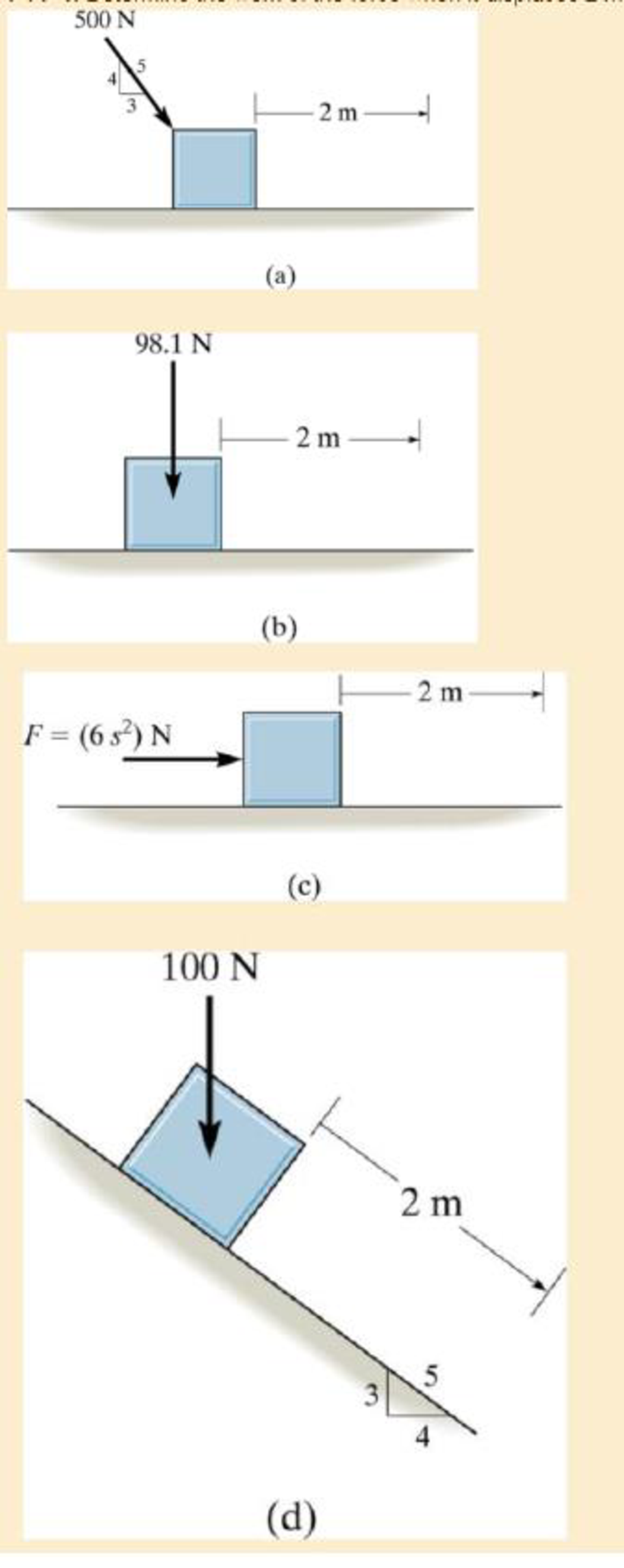
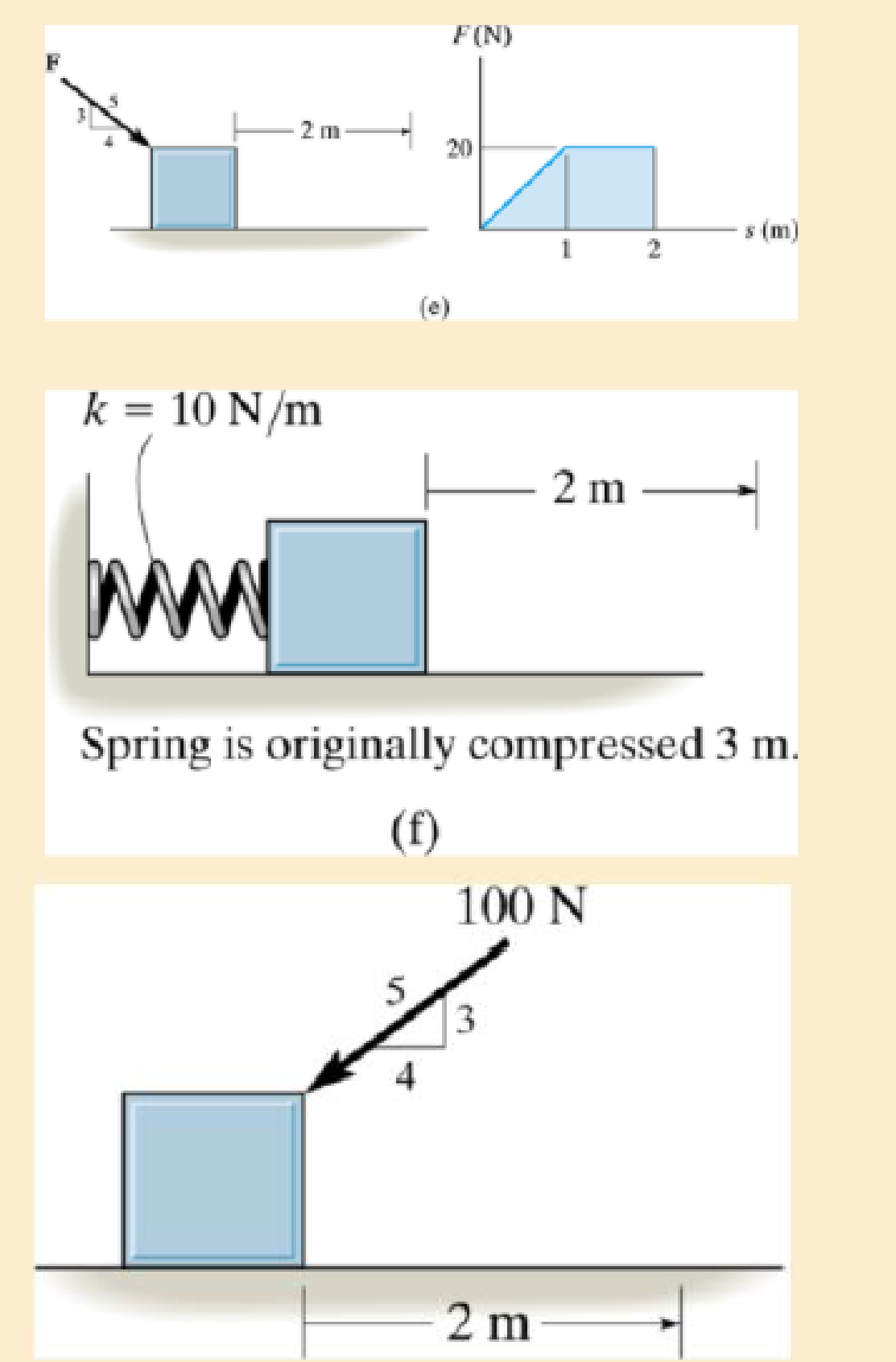
a)
The work of a force.
Answer to Problem 1PP
The work done by the force on the block is
Explanation of Solution
Given:
The force acting on the block is
The displacement of the block is
Draw the free body diagram of block as shown in Figure (a).
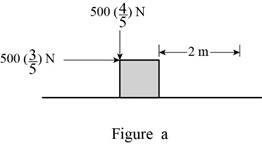
Write the formula for work done force
Here,
Conclusion:
Refer Figure (a).
Resolve the force along
Substitute
Thus, the work done by the force on the block is
b)
The work of a force.
Answer to Problem 1PP
The work done by the force on the block is
Explanation of Solution
Given:
The force acting on the block is
The displacement of the block is
Draw the free body diagram of block as shown in Figure (b).

Write the formula for work done force
Here,
Conclusion:
Refer Figure (1).
The force acting on the block does not cause any displacement of the block. Hence the work done by the force is zero.
Thus, the work done by the force on the block is
c)
The work of a force.
Answer to Problem 1PP
The work done by the force on the block is
Explanation of Solution
Given:
The force acting on the block is
The displacement of the block is
Draw the free body diagram of block as shown in Figure (c).

Write the formula for work done force
Here,
Conclusion:
Refer Figure (c).
Substitute
Thus, the work done by the force on the block is
d)
The work of a force.
Answer to Problem 1PP
The work done by the force on the block is
Explanation of Solution
Given:
The force acting on the block is
The displacement of the block is
Draw the free body diagram of block as shown in Figure (d).
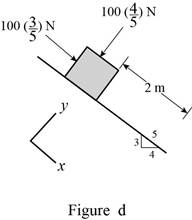
Write the formula for work done force
Here,
Conclusion:
Refer Figure (d).
Resolve the force along
Substitute
Thus, the work done by the force on the block is
e)
The work of a force.
Answer to Problem 1PP
The work done by the force on the block is
Explanation of Solution
Given:
The displacement of the block is
The given
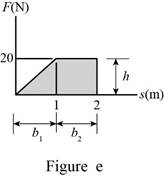
Draw the free body diagram of block as shown in Figure (1e).
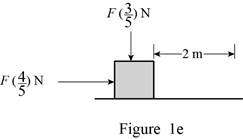
The graph consists of two geometrical cross sectional areas namely triangle and rectangle.
Write the formula for work done force
Here,
Refer Figure (e).
Write the formula for triangle.
Write the formula for rectangle.
Conclusion:
Refer Figure (e).
Calculate the area under the
Substitute
Substitute
Calculate the work done by the force
Substitute
Thus, the work done by the force on the block is
f)
The work of a spring force.
Answer to Problem 1PP
The work done by the force on the block is
Explanation of Solution
Given:
The stiffness of the spring is
The spring is originally compressed to
Draw the free body diagram of block as shown in Figure (f).
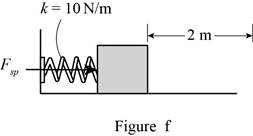
Write the formula for work done force
Here,
Conclusion:
Refer Figure (f).
Here, the block is subjected to spring force only.
When the spring is originally compressed to
When the spring is released, the displaced to
Substitute
Thus, the work done by the spring force on the block is
g)
The work of a force.
Answer to Problem 1PP
The work done by the force on the block is
Explanation of Solution
Given:
The force acting on the block is
The displacement of the block is
Draw the free body diagram of block as shown in Figure (g).
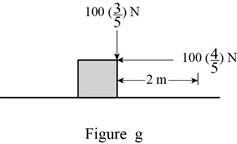
Write the formula for work done force
Here,
Conclusion:
Refer Figure (g).
Resolve the force along
Substitute
Thus, the work done by the force on the block is
Want to see more full solutions like this?
Chapter 14 Solutions
Engineering Mechanics: Dynamics, Study Pack, Si Edition
- The flow rate is 12.275 Liters/s and the diameter is 6.266 cm.arrow_forwardAn experimental setup is being built to study the flow in a large water main (i.e., a large pipe). The water main is expected to convey a discharge (Qp). The experimental tube will be built at a length scale of 1/20 of the actual water main. After building the experimental setup, the pressure drop per unit length in the model tube (APm/Lm) is measured. Problem (20): Given the value of APm/Lm [kPa/m], and assuming pressure coefficient similitude, calculate the drop in the pressure per unit length of the water main (APP/Lp) in [Pa/m]. Givens: AP M/L m = 590.637 kPa/m meen Answers: ( 1 ) 59.369 Pa/m ( 2 ) 73.83 Pa/m (3) 95.443 Pa/m ( 4 ) 44.444 Pa/m *******arrow_forwardFind the reaction force in y if Ain = 0.169 m^2, Aout = 0.143 m^2, p_in = 0.552 atm, Q = 0.367 m^3/s, α = 31.72 degrees. The pipe is flat on the ground so do not factor in weight of the pipe and fluid.arrow_forward
- Find the reaction force in x if Ain = 0.301 m^2, Aout = 0.177 m^2, p_in = 1.338 atm, Q = 0.669 m^3/s, and α = 37.183 degreesarrow_forwardProblem 5: Three-Force Equilibrium A structural connection at point O is in equilibrium under the action of three forces. • • . Member A applies a force of 9 kN vertically upward along the y-axis. Member B applies an unknown force F at the angle shown. Member C applies an unknown force T along its length at an angle shown. Determine the magnitudes of forces F and T required for equilibrium, assuming 0 = 90° y 9 kN Aarrow_forwardProblem 19: Determine the force in members HG, HE, and DE of the truss, and state if the members are in tension or compression. 4 ft K J I H G B C D E F -3 ft -3 ft 3 ft 3 ft 3 ft- 1500 lb 1500 lb 1500 lb 1500 lb 1500 lbarrow_forward
- Problem 14: Determine the reactions at the pin A, and the tension in cord. Neglect the thickness of the beam. F1=26kN F2 13 12 80° -2m 3marrow_forwardProblem 22: Determine the force in members GF, FC, and CD of the bridge truss and state if the members are in tension or compression. F 15 ft B D -40 ft 40 ft -40 ft 40 ft- 5 k 10 k 15 k 30 ft Earrow_forwardProblem 20: Determine the force in members BC, HC, and HG. After the truss is sectioned use a single equation of equilibrium for the calculation of each force. State if the members are in tension or compression. 5 kN 4 kN 4 kN 3 kN 2 kN B D E F 3 m -5 m- -5 m- 5 m 5 m-arrow_forward
- An experimental setup is being built to study the flow in a large water main (i.e., a large pipe). The water main is expected to convey a discharge (Qp). The experimental tube will be built at a length scale of 1/20 of the actual water main. After building the experimental setup, the pressure drop per unit length in the model tube (APm/Lm) is measured. Problem (19): Given the value of Qp [m³/s], and assuming Reynolds number similitude between the water main and experimental tube, calculate the flow rate in the model tube (Qm) in [lit/s]. = 30.015 m^3/sarrow_forwardProblem 11: The lamp has a weight of 15 lb and is supported by the six cords connected together as shown. Determine the tension in each cord and the angle 0 for equilibrium. Cord BC is horizontal. E 30° B 60° Aarrow_forwardProblem 10: If the bucket weighs 50 lb, determine the tension developed in each of the wires. B $30° 5 E D 130°arrow_forward
 International Edition---engineering Mechanics: St...Mechanical EngineeringISBN:9781305501607Author:Andrew Pytel And Jaan KiusalaasPublisher:CENGAGE L
International Edition---engineering Mechanics: St...Mechanical EngineeringISBN:9781305501607Author:Andrew Pytel And Jaan KiusalaasPublisher:CENGAGE L
